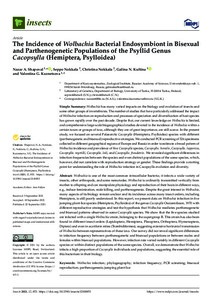The incidence of Wolbachia bacterial endosymbiont in bisexual and parthenogenetic populations of the psyllid genus Cacopsylla (Hemiptera, Psylloidea)
Shapoval Nazar A.; Nokkala Seppo; Nokkala Christina; Kuftina Galina N.; Kuznetsova Valentina G.
https://urn.fi/URN:NBN:fi-fe2021110554165
Tiivistelmä
Wolbachia is one of the most common intracellular bacteria; it infects a wide variety of insects, other arthropods, and some nematodes. Wolbachia is ordinarily transmitted vertically from mother to offspring and can manipulate physiology and reproduction of their hosts in different ways, e.g., induce feminization, male killing, and parthenogenesis. Despite the great interest in Wolbachia, many aspects of its biology remain unclear and its incidence across many insect orders, including Hemiptera, is still poorly understood. In this report, we present data on Wolbachia infection in five jumping plant-lice species (Hemiptera, Psylloidea) of the genus Cacopsylla Ossiannilsson, 1970 with different reproductive strategies and test the hypothesis that Wolbachia mediates parthenogenetic and bisexual patterns observed in some Cacopsylla species. We show that the five species studied are infected with a single Wolbachia strain, belonging to the supergroup B. This strain has also been found in different insect orders (Lepidoptera, Hemiptera, Plecoptera, Orthoptera, Hymenoptera, Diptera) and even in acariform mites (Trombidiformes), suggesting extensive horizontal transmission of Wolbachia between representatives of these taxa. Our survey did not reveal significant differences in infection frequency between parthenogenetic and bisexual populations or between males and females within bisexual populations. However, infection rate varied notably in different Cacopsylla species or within distinct populations of the same species. Overall, we demonstrate that Wolbachia infects a high proportion of Cacopsylla individuals and populations, suggesting the essential role of this bacterium in their biology.
Kokoelmat
- Rinnakkaistallenteet [27094]
